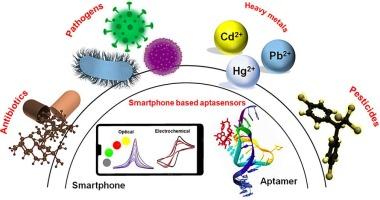新趋势:能检测病原体和化学污染的智能手机辅助灵敏传感器
IF 4.9
2区 化学
Q1 CHEMISTRY, ANALYTICAL
引用次数: 0
摘要
及时、快速地检测病原体和环境污染物对于保障人类健康和预防危机至关重要。病原体、抗生素残留、杀虫剂和重金属因其快速传播而对人类生命和经济构成重大威胁。开发检测和防止污染物扩散的有效方法仍然是一项重大挑战。近年来,研究人员一直在探索创新的传感方法,利用智能手机作为多功能传感工具,实现简便、便携、经济高效的检测。将智能手机与检测方法相结合,只需简单拍照就能方便地获取结果。具有高亲和力和高选择性的 Aptamers 已在生物传感领域受到广泛关注,并越来越多地被用于设计基于光学或电化学原理的新型检测方法。此外,还可以开发智能手机应用程序,根据光学或电化学信号处理图像和分析结果,准确确定病原体的负荷。除适配体外,基于智能手机的检测平台还可利用其他传感元件,如抗体、碳水化合物和蛋白质。将智能手机与检测化验相结合,简化了检测程序,使其便携、灵敏度高。本综述重点介绍基于智能手机的生物传感应用设备的最新技术进展,突出其在病原体和污染物快速检测方面的潜力。本文章由计算机程序翻译,如有差异,请以英文原文为准。

Emerging trends: Smartphone-assisted aptasensors enabling detection of pathogen and chemical contamination
The timely and rapid detection of pathogens and environmental contaminants is critical in safeguarding human health and preventing crises. Pathogens, antibiotic residues, pesticides, and heavy metals pose significant threats to human lives and the economy due to their rapid spread. Developing effective methods for detecting and preventing contaminant spread remains a major challenge. Researchers have been exploring innovative sensing approaches to enable easy, portable, and cost-effective detection using smartphones as versatile sensing tools in recent years. Integrating smartphones with detection assays allows for convenient result acquisition through a simple photograph. Aptamers, with their high affinity and selectivity, have gained substantial interest in biosensing, and they are increasingly employed in the design of novel detection assays based on optical or electrochemical principles. Additionally, smartphone applications can be developed to process images and analyze results based on optical or electrochemical signals, accurately determining pathogen loads. Apart from aptamers, smartphone-based detection platforms also utilize other sensing elements, such as antibodies, carbohydrates, and proteins. Coupling smartphones with detection assays simplifies the detection procedure, making it portable and highly sensitive. This review focuses on the latest technological advancements in smartphone-based devices for biosensing applications, highlighting their potential for rapid pathogen and contaminant detection.
求助全文
通过发布文献求助,成功后即可免费获取论文全文。
去求助
来源期刊

Microchemical Journal
化学-分析化学
CiteScore
8.70
自引率
8.30%
发文量
1131
审稿时长
1.9 months
期刊介绍:
The Microchemical Journal is a peer reviewed journal devoted to all aspects and phases of analytical chemistry and chemical analysis. The Microchemical Journal publishes articles which are at the forefront of modern analytical chemistry and cover innovations in the techniques to the finest possible limits. This includes fundamental aspects, instrumentation, new developments, innovative and novel methods and applications including environmental and clinical field.
Traditional classical analytical methods such as spectrophotometry and titrimetry as well as established instrumentation methods such as flame and graphite furnace atomic absorption spectrometry, gas chromatography, and modified glassy or carbon electrode electrochemical methods will be considered, provided they show significant improvements and novelty compared to the established methods.
 求助内容:
求助内容: 应助结果提醒方式:
应助结果提醒方式:


